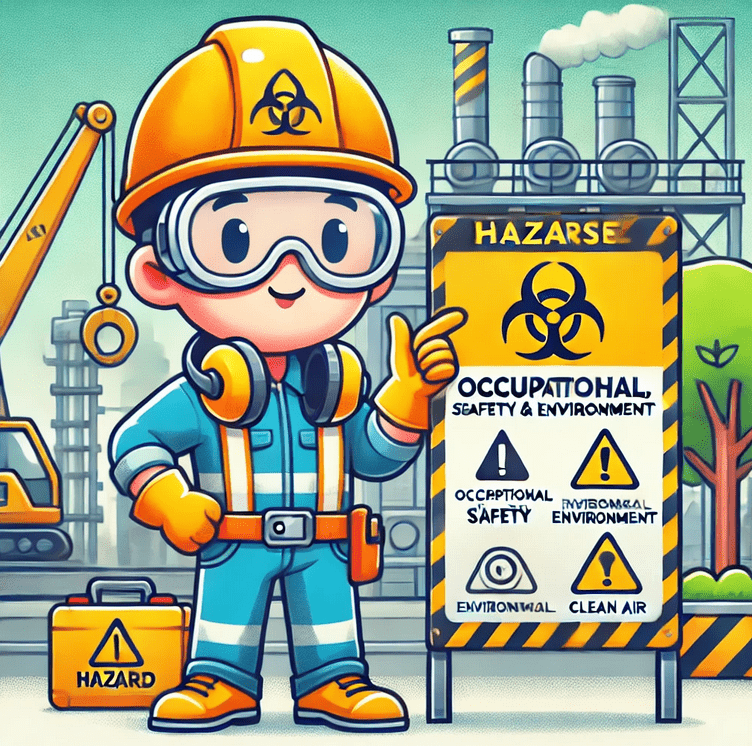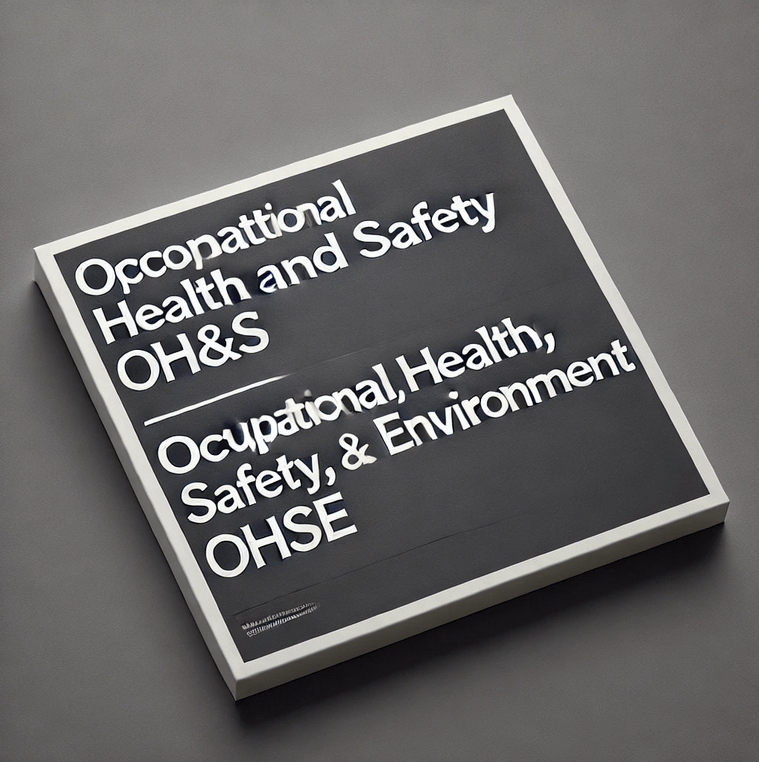Occupational Health and Safety (OH&S) and Occupational Health, Safety, and Environment (OHSE) are multidisciplinary fields aimed at safeguarding workers’ health, safety, and environmental well-being. These areas involve anticipating, identifying, assessing, and controlling hazards that could result in workplace injuries, illnesses, or environmental degradation.
Understanding the core principles of OH&S and OHSE is critical for creating safer, healthier, and more sustainable workplaces. This article covers the fundamental principles of both OH&S and OHSE, including the legal framework, hazard identification, risk management, and the importance of worker involvement.

- 1. Key Components of OH&S and OHSE
- 2. The Legal Framework of OH&S and OHSE
- 3. Hazard Identification and Risk Management
- 4. Preventive Measures and Control Strategies
- 5. Worker Participation and Training
- 6. Environmental Protection in OHSE
- 7. Examples of OH&S and OHSE Applications
- 8. Quiz on Fundamental Principles of OH&S and OHSE
- 9. Summary Notes
1. Key Components of OH&S and OHSE
| Component | Description |
|---|---|
| Legal Framework | Laws, regulations, and standards that govern OH&S and OHSE in the workplace and ensure worker and environmental protection. |
| Risk Management | The process of identifying, evaluating, and controlling workplace hazards and environmental risks. |
| Hazard Identification | The recognition of physical, chemical, biological, ergonomic, and psychosocial hazards in the workplace. |
| Control Measures | Methods and technologies implemented to eliminate or reduce identified risks and hazards. |
| Worker Participation | Involvement of employees in the development, implementation, and monitoring of OH&S and OHSE programs. |
| Environmental Impact | Measures to assess and control the impact of workplace activities on the environment, including waste management and pollution prevention. |
2. The Legal Framework of OH&S and OHSE
Occupational Health and Safety (OH&S)
The legal framework for OH&S is established by government regulations, including labor laws and safety standards. Key pieces of legislation often include:
- Occupational Safety and Health Administration (OSHA) in the U.S.
- Workplace Safety and Insurance Act (WSIA) in Canada
- Health and Safety at Work Act (HSWA) in the U.K.
These laws set minimum safety standards and provide guidelines for employers and employees to ensure safe working conditions.
Occupational Health, Safety, and Environment (OHSE)
OHSE goes beyond worker safety and incorporates environmental protection. The legal framework for OHSE includes environmental laws, such as:
- Environmental Protection Act (EPA) in various countries
- Clean Air Act and Clean Water Act (U.S.)
- Pollution Prevention and Control (PPC) Regulations
These regulations ensure that companies not only protect their employees but also prevent environmental damage, including waste management, air, and water pollution.
3. Hazard Identification and Risk Management
Hazard Identification
The first step in preventing accidents and illnesses is identifying potential hazards. Common workplace hazards include:
- Physical Hazards: Unsafe machinery, electrical hazards, noise, and vibration.
- Chemical Hazards: Exposure to harmful chemicals, including gases, dust, and fumes.
- Biological Hazards: Bacteria, viruses, and other pathogens in healthcare or laboratory environments.
- Ergonomic Hazards: Poor workstation design, repetitive motion, and improper lifting techniques.
- Psychosocial Hazards: Stress, harassment, and work-related fatigue.
Risk Management Process
Risk management in OH&S and OHSE involves assessing the probability and severity of hazards, followed by implementing control measures. The steps in the risk management process include:
- Hazard Identification
- Risk Assessment: Estimating the likelihood and impact of the identified hazards.
- Control Measures: Implementing preventive actions to eliminate or mitigate the risks.
- Monitoring and Review: Continuously assessing the effectiveness of control measures.
| Risk Level | Action Required |
|---|---|
| High Risk | Immediate action required to control the hazard. |
| Medium Risk | Corrective measures must be planned and applied. |
| Low Risk | Regular monitoring and minor adjustments. |
4. Preventive Measures and Control Strategies
Preventive measures are key to reducing risks and promoting safety. Control strategies fall into several categories:
- Elimination: Removing the hazard entirely, e.g., replacing a dangerous chemical with a safer one.
- Substitution: Replacing the hazardous process or substance with something less harmful.
- Engineering Controls: Isolating people from the hazard through mechanical means such as ventilation or machine guards.
- Administrative Controls: Changing work practices, such as rotating shifts to reduce exposure to hazards.
- Personal Protective Equipment (PPE): Using protective gear such as helmets, gloves, masks, and goggles.
| Control Type | Example |
|---|---|
| Elimination | Replacing a hazardous chemical with a safe one. |
| Engineering Controls | Installing ventilation systems to remove fumes. |
| Administrative Controls | Enforcing safe work procedures. |
| PPE | Providing respirators and gloves. |
5. Worker Participation and Training
Worker involvement is critical to the success of OH&S and OHSE programs. Employees should be trained to recognize hazards and use control measures effectively. This includes:
- OH&S Training: Teaching employees how to use PPE, handle hazardous materials, and follow emergency procedures.
- Safety Committees: Establishing committees where workers can contribute to safety programs and suggest improvements.
- Reporting Systems: Encouraging workers to report unsafe conditions and near-miss incidents without fear of retaliation.
6. Environmental Protection in OHSE
OHSE also emphasizes the environmental impacts of workplace activities. Companies should implement programs to:
- Reduce Waste: Implement recycling programs and reduce hazardous waste generation.
- Prevent Pollution: Control emissions, reduce water contamination, and manage waste effectively.
- Sustainability Initiatives: Adopt practices that reduce the environmental footprint, such as energy-efficient technologies and resource conservation.
7. Examples of OH&S and OHSE Applications
- Manufacturing Industry:
- Hazard: Exposure to loud noise from machinery.
- Control Measure: Installation of noise dampening barriers and provision of hearing protection.
- Healthcare:
- Hazard: Biological hazards from bloodborne pathogens.
- Control Measure: Use of personal protective equipment (PPE) like gloves and face shields, along with proper disposal of sharps.
- Construction Industry:
- Hazard: Falls from heights.
- Control Measure: Use of fall arrest systems, safety nets, and proper scaffolding.
8. Quiz on Fundamental Principles of OH&S and OHSE
Test your understanding of the principles discussed with the following questions:
- Which of the following is considered a psychosocial hazard?
- a) Loud noise
- b) Exposure to chemicals
- c) Work-related stress
- d) Incorrect lifting techniques
- What is the first step in the risk management process?
- a) Control measures
- b) Risk assessment
- c) Hazard identification
- d) Monitoring and review
- Which type of control measure involves substituting a less hazardous material?
- a) Engineering controls
- b) Substitution
- c) PPE
- d) Administrative controls
- What does OHSE include that OH&S does not?
- a) Worker safety
- b) Environmental protection
- c) Risk assessment
- d) Personal protective equipment
9. Summary Notes
- OH&S and OHSE focus on the protection of workers and the environment from hazards.
- Legal frameworks ensure compliance with national safety standards.
- Risk management includes identifying hazards, assessing risks, and implementing control measures.
- Preventive strategies include elimination, substitution, engineering controls, administrative controls, and PPE.
- Worker participation and training are critical to effective OH&S programs.
- OHSE extends safety measures to environmental protection, ensuring sustainable and responsible practices.
By understanding and applying these fundamental principles, organizations can create safer workplaces and contribute to the well-being of both employees and the environment.


No comments yet